 Research Article
Research Article
Research on Human-Induced Vibration of Spatial Rope Deck Suspension Bridges
Jiepeng Zhang and Kongliang Chen*
School of Civil Engineering and Architecture, Wuyi University, Jiangmen 529020, China
Kongliang Chen, School of Civil Engineering and Architecture, Wuyi University, Jiangmen 529020, China.
Received Date: September 07, 2022; Published Date:September 26, 2022
Abstract
It is mean to study the effect of different pedestrian load conditions on the human-induced vibration response of the spatial cable surface suspension bridge and to provide effective vibration reduction measures. In this paper, the Xiasha pedestrian bridge was taken by Midas Civil software to establish the bridge formation stage model of space rope deck suspension bridge in Jiangmen City as the research background. Through the research, the corresponding rules are summarized, and some references are provided for the same type of projects.
Keywords:Human-induced vibration; Spatial rope deck suspension bridge; Comfort evaluation; Vibration damping control
Introduction
In recent years, a large number of pedestrian suspension bridges have been built around China for the convenience of the public, which have become a beautiful scenery of the city with their beautiful and chic shapes. The Millennium Bridge incident in the UK has drawn the attention of researchers to the problem of human-induced vibration in urban bridges. A large number of studies on human-induced vibration have been conducted abroad [1-4]. Among them, Fujino [1] reported and studied the lateral vibration of T-bridge in Japan and took damping measures. Yuan [5] described and studied the human-induced vibration calculation method of pedestrian bridges: Qiao [6] calculated the human-induced vibration of bridges under walking and running loads based on the German design guidelines for pedestrian bridges and made damping control measures; Chen [7] and Zhang [8] introduced the human-induced vibration theory and dynamic design methods. However, there is less research on the human-induced vibration response of space cable deck suspension bridges. Compared with traditional suspension bridges, the structure of this type of suspension bridges is novel, the boom is arranged in an inclined manner, and the spatial three-dimensional system is formed between the boom, the main cable and the main girder, which makes the force situation of this type of suspension bridges more complex and mainly sensitive to dynamic effects. Therefore, it is necessary to study the self-oscillation frequency and human-induced vibration response of spatial cable deck suspension bridges. In this paper, the human-induced vibration problem is studied in the case of a suspension bridge with space cable deck. The comfort of the bridge under four types of pedestrian load conditions from 0.2 to 1.5 p/ m2 is analyzed, and the comfort of the bridge is evaluated by calculating the vibration response of the bridge under crowd loading with reference to the human-induced vibration calculation method in the German EN03 code.
Finite Element Model and Self-Oscillation Response Analysis
Project summary and finite element model of space rope deck suspension bridge
Jiangmen Xiasha Pedestrian Landscape Flyover is located on the south side of the intersection of Jiangmen and Wuzhou waterways in Jianghai District. The bridge is a single main cable form of space rope surface suspension bridge, arranged 24.85m + 92m + 24.85m = 141.7m single-span ground-anchored suspension bridge. The bridge width of 4m split steel box girder is used. The main bridge adopts a single-span suspension bridge system with double main cables and double booms. The spacing of boom is 5m, and the lower end is anchored on the crossbeam. The whole bridge superstructure is made of steel, and the pedestrian landscape flyover in Xia Sha, Jiangmen City is shown in Figure 1.
Figure 1:Xiasha pedestrian landscape footbridge.
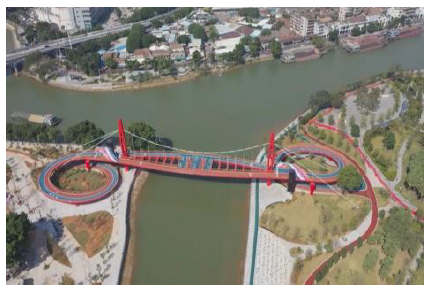
In this paper, the pedestrian landscape bridge in Xiasha, Jiangmen City is modeled by Midas Civil finite element software. The main cable and boom material are used is 1860 steel strand for simulation. The boom consists of 34 units. The main cable consists of 18 units. The overall model of the bridge is shown in Figure 2.
Figure 2:Finite element model of spatial rope deck suspension bridge.

Determine the sensitive frequency range
In this paper, the sensitive range of self-oscillation frequency of the space cable deck suspension bridge is determined by referring to the domestic specification: vertical vibration frequency: 1.25~3 Hz; transverse vibration frequency: 0.5~1.2 Hz.
The eigenvalue analysis using Lanczos analysis method in the finite element model of the space cable deck suspension bridge shown in Figure 2 was used to analyze the self-oscillation response characteristics of the suspension bridge and to determine the sensitive frequency range.
From the above, the vertical self-oscillation frequency of the 3rd order of the structure is 2.840 Hz, which is located in the sensitive range of vertical vibration frequency 1.25~3Hz and needs to be analyzed for human-induced vibration comfort. The transverse self-oscillation frequency of the first order of the structure is 0.781 Hz, which is in the sensitive range of transverse frequencies from 0.5 to 1.2 Hz and requires human-induced vibration comfort analysis.
Self-oscillation response analysis
The pedestrian density is taken as 0.2 p/m2, 0.5 p/m2, 1.0 p/m2, and 1.5 p/m2, respectively, and the crowd load is calculated together with the self-weight of the structure for the eigenvalue response analysis to summarize the main beam vertical bending and lateral bending self-oscillation frequencies in the sensitive frequency range, as shown in Table 1.
Table 1:Self-vibration frequency of the structure under different pedestrian load conditions (Hz).

From Table 1, it can be seen that the structural inherent frequency of the space cable deck suspension bridge is low. Under different pedestrian loading conditions, the self-oscillation frequencies of the structure of each order vary; By increasing the pedestrian load condition, the self-oscillation frequency of the structure of the same order decreases accordingly.
Comparing with the structure inherent frequency, the main girder vertical bending self-oscillation frequency is reduced by 6.7 % and the main girder side bending self-oscillation frequency is reduced by 1.7 % when considering the working condition of 1.5 p/ m2 pedestrian density, which shows that the human-induced vibration has a significant effect on the self-oscillation response characteristics of the spatial cable deck suspension bridge.
Human-Induced Vibration Response Analysis of Spatial Rope Deck Suspension Bridges
Pedestrian load
The pedestrian simple harmonic walking load is applied by the equivalent crowd load method, four load conditions with different pedestrian densities are selected, then the pedestrian load model is established, the pedestrian harmonic load is loaded onto the bridge formation stage model, the maximum acceleration in the span of the spatial cable deck suspension bridge is calculated by the time domain analysis method, and the comfort analysis is performed according to the maximum acceleration.
Modeling pedestrian harmonic loads
The German EN03 code states that the vertical bending and side bending pedestrian harmonic load models are calculated according to equations (1) and (2), respectively.

Where fv is the self-oscillation frequencies of the analyzed vertical bending modes and fh is the self-oscillation frequency of the analyzed side-bending mode. n’ is the fully synchronized pedestrian density. ψv is the discount factor of vertical and ψh is the discount factor of lateral.
Human-induced vibration response analysis
The self-oscillation frequencies of the vertical bending mode and the lateral bending mode are obtained from the finite element software analysis, and the vertical and lateral reduction coefficients are determined according to the German EN03 code calculation method, and the calculated parameters of the pedestrian harmonic load are summarized in Table 2.
Table 2:Self-vibration frequency of the structure under different pedestrian load conditions (Hz).

The calculation parameters in Table 2 will be brought into the formula (1) and formula (2) can be obtained for each unit area crowd load function, this time to crowd density 1.5 p/m2 working condition as an example, the calculation process is as follows
The crowd density is 1.5 p/m2. The main span of this bridge is 92m. The width of bridge is 4 m. The bridge deck area is 368 m2. The total number of people on the bridge is 552.The pedestrian Flow Equivalent Number is 0.118 p/m2.
Unit area crowd loading function:

From the above, the acceleration time curve of the span node of the main beam under 1.5 p/m2 pedestrian load condition can be obtained, as shown in Figure 3 and Figure 4. Figure 3 shows the vertical acceleration time course of the node in the span of the main beam at order 3 for the vertical pedestrian step frequency; Figure 4 shows the lateral acceleration time course of the node in the span of the main beam at order 1 for the lateral pedestrian step frequency.
Figure 3:Time course of vertical acceleration under 1.5 p/m2 working condition.
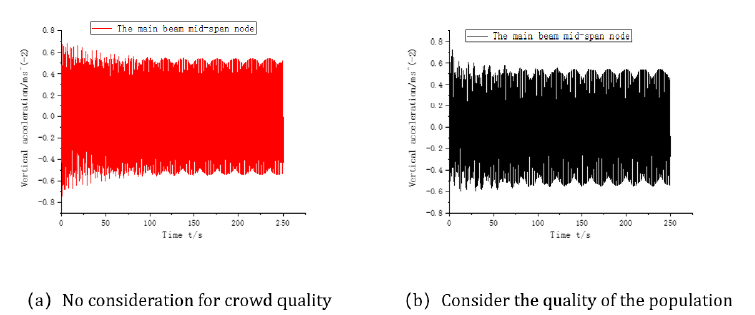
Figure 4:Time course of lateral acceleration under 1.5 p/m2 working condition.
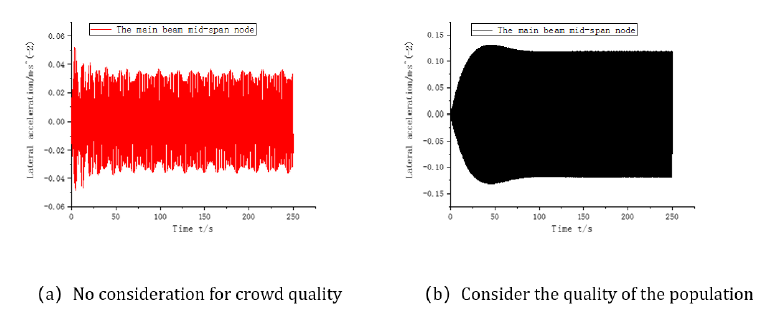
The acceleration time curves of the span nodes of the main beam under four pedestrian load conditions from 0.2 to 1.5 p/m2 were calculated separately, and the maximum acceleration in each time curve when the crowd mass was considered and not considered were compared.
From Figure 5, it can be seen that pedestrian flow has a significant effect on the spanwise acceleration of the main girder of the spatial rope deck suspension bridge, and the maximum acceleration of the main girder corresponding to different flows generally increases after considering the crowd mass, among which in the maximum lateral acceleration of the main girder, there is a 60.3% difference in the maximum lateral acceleration of the main girder after considering the crowd mass compared to not considering the crowd mass, which is caused by the difference in the discount factor in modeling the pedestrian harmonic load in vertical bending and lateral bending. This is caused by the different discount factors in the modeling of vertical and lateral bending pedestrian harmonic loads.
Figure 5:Variation of the maximum acceleration of the main beam with the density of pedestrians.
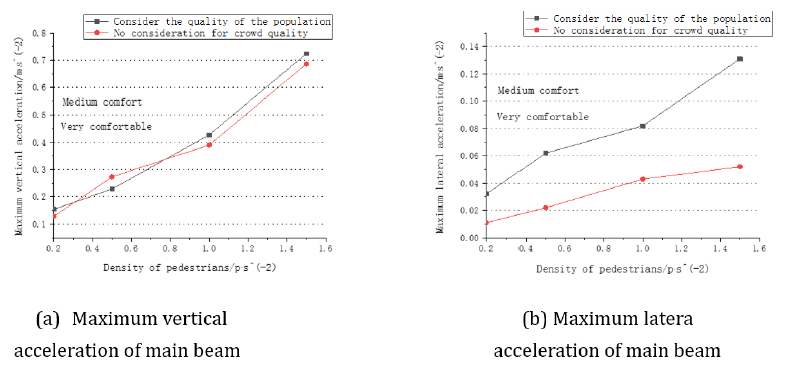
Pedestrian comfort evaluation
In this paper, referring to the German specification, the pedestrian comfort is defined as shown in Table 3.
According to Table 3 and Figure 5, the pedestrian comfort during the service period of the space cable deck suspension bridge was evaluated, and the results are shown in Table 4.
Table 3:Definition of pedestrian comfort in the German EN03 specification.

Table 4:Evaluation results of pedestrian comfort of spatial rope deck suspension bridges.

From Table 4, it can be seen that pedestrians are no longer in a very comfortable state after exceeding 1.5 p/m2 working condition, from which it can be concluded that the space cable deck suspension bridge should be damped in the case of high pedestrian flow to ensure that pedestrians are in a very comfortable state in this bridge, considering the crowd quality has practical significance. In this paper, the pedestrian density of 1.5 p/m2 is selected for vibration control.
Vibration Damping Measures
Parameter design of TMD dampers
According to the German EN03 specification, measures can be taken to improve the dynamic performance of suspension bridges with space cable faces that do not meet the limit values. The main measures include: change of mass; change of stiffness; change of structural damping; increase of damping. The design parameters of the TMD dampers are shown in Table 5.
Table 5:Design parameters of TMD dampers.

Analysis of vibration damping effect
According to the vibration diagram, the TMD dampers are arranged at the maximum deformation, and the acceleration time curves in the span of the main beam before and after damping under the equivalent crowd load condition are shown in Figure 6. According to Figure 6, the damping efficiency was obtained by comparing the maximum acceleration of each order before and after damping (see Table 6).
Table 6:Comparison of maximum acceleration before and after damping.

Figure 6:Time course of acceleration of main beam before and after damping at 1.5 p/m2 working condition.
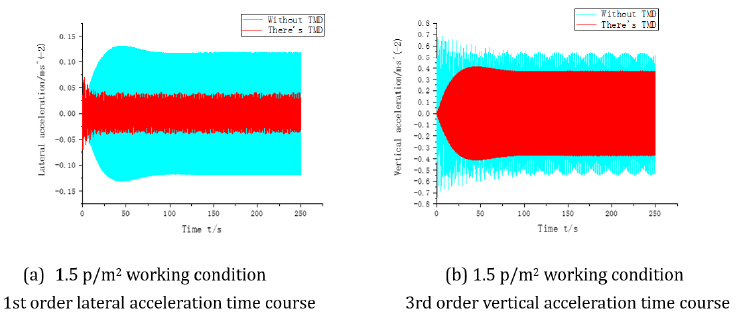
As can be seen from Table 6, under the equivalent crowd load, the acceleration maximum value of the nodes in the span of the main beam is significantly reduced after setting the TMD dampers, and all the comfort levels of the bridge meet the comfort standard requirements, which has played a good vibration reduction effect.
Malware Detection
In this paper, the dynamic response analysis of human-induced
vibration on space cable deck suspension bridges is studied, and
finally, vibration damping measures are carried out for the unfavorable
working condition of pedestrian density of 1.5 p/m2.
• The self-oscillation frequency of the spatial cable deck suspension
bridge is low, and the self-oscillation frequency of the
bridge decreases with the increase of pedestrian density when
considering the crowd mass, including the maximum decrease
of 6.72 % in the vertical bending frequency of the main girder
and 1.66 % in the lateral bending frequency of the main girder
within the working condition of 1.5 p/m2 from not considering
the crowd mass to the pedestrian density.
• With the increase of pedestrian density, both vertical and lateral
accelerations of the nodes in the span of the main girders
increase, which shows that the crowd load has a significant
effect on the lateral acceleration of the space cable deck suspension
bridge.
• After considering the mass of the crowd, the space cable deck
suspension bridge is very comfortable for pedestrians in the
range of pedestrian density 0.2~1.0 p/m2. Under the condition
of 1.5 p/m2 pedestrian density, the pedestrians are in a moderate
comfortable state, which does not meet the requirements
of comfort level. The maximum acceleration of the structure
meets the requirements of comfort level by adding TMD dampers,
which shows that TMD dampers have obvious effects on
reducing the vibration response of the space cable deck suspension
bridge.
Acknowledgement
None.
Conflict of Interest
No conflict of interest.
References
- Fujino Y, Pacheco BM,Nakamura SI , et al. (1993) Synchronization of human walking observed during lateral vibration of a congested pedestrian bridge. Earthquake Engineering & Structural Dynamics 22(9): 741-758.
- Dallard P,Fitzpatrick T,Flint A,et al. (2001) The London Millennium Footbridge. Structural Engineer 79(171): 17-33.
- Nakamura S, Toshitsugu Kawasaki (2006) Lateral vibration of footbridges by synchronous walking. Journal of Constructional Steel Research 62(11): 1148-1160.
- Andriacchi TP,Ogle JA,Galante JO (1977) Walking speed as a basis for normal and abnormal gait measurements. Journal of Biomechanics 10(4): 261-268.
- Xubin Yuan (2006) Study on human-induced vibration characteristics of pedestrian bridges. Tongji University.
- Yunqiang Qiao, Guinan Wu (2018) Research on human-induced vibration of single main cable suspension bridges and vibration reduction control. World Bridges 46(02): 68-73.
- Zhengqing Chen, Guangdong Liu (2009) Human-induced vibration theory and dynamic design of pedestrian bridges. Engineering Mechanics 26(S2): 148-159.
- Yanling Zhang, Jianlin Zhang, Yansheng Li (2020) Analysis of human-induced vibration of flexible pedestrian suspension bridges under different pedestrian flows. Journal of Xi'an University of Architecture and Technology (Natural Science Edition) 52(06): 779-787.
-
Jiepeng Zhang and Kongliang Chen*. Research on Human-Induced Vibration of Spatial Rope Deck Suspension Bridges. Glob J Eng Sci. 10(1): 2022. GJES.MS.ID.000730.
-
Human-induced vibration, Spatial rope deck suspension bridge, Comfort evaluation, Vibration damping control
-

This work is licensed under a Creative Commons Attribution-NonCommercial 4.0 International License.






